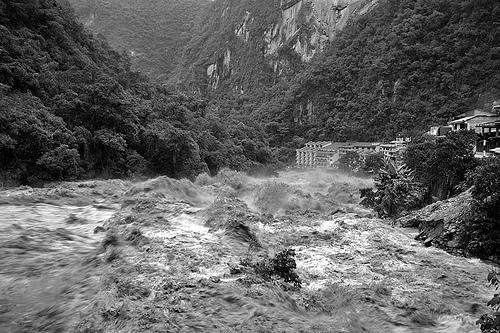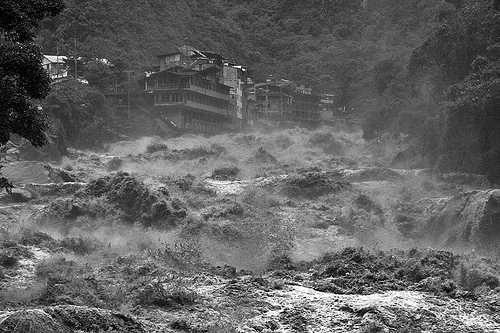After two weeks of heavy rain and non-stop rainfall and following floods of Cusco, Puno and Apurímac, the citizen media has thoroughly covered the disaster in South Peru, while traditional media is now focusing on other affected zones like North shore [es], the North Jungle [es] and the Central Jungle.

Photo by Alfredo Velarde. Used following a Creative Commons license. Taken from http://www.flickr.com/photos/velardemariscal/4316299488/in/set-72157623188793247/
A persistent idea in the Cusco blogosphere is the lack of prevention [es] from the local and regional governments for this type of disaster that seems to happen every year. Frida Ibáñez from Crónicas desde el centro Cusco explained the geography and characteristics of the city, and questioned why there is no planning nor prevention from the authorities [es]:
Ha llovido por cuatro días consecutivos con breves descansos, el cielo parecía no contenerse y caía agua de forma estrepitosa. Los ríos en las calles crecían cada vez más. No recuerdo una lluvia así de fuerte desde mi infancia … El Cusco es una hoyada. No es por gusto que la llaman ombligo… su geografía es particular. … Es en época de secas, entre mayo a setiembre que deberían hacerse la limpieza de los ríos, tal como lo hacían los Incas. Podríamos prevenir las pérdidas ante una eventualidad climática como la última. Nos preguntamos: ¿qué hacen las autoridades con el dinero que Cusco recibe del canon minero? recordemos que hace unos años se devolvió dinero de la Región Cusco a Lima porque no hubo capacidad de gasto y gestión.
Frida also wrote about helping those affected by the rain [es]. CafeHenry from the blog El Placard “H” also commented on the reaction from the government [es] .

Photo by Alfredo Velarde. Used following a Creative Commons license. Taken from http://www.flickr.com/photos/velardemariscal/4315585687/in/set-72157623188793247/
Alfredo Velarde was visiting the town of Aguas Calientes, on the foothill of Machu Picchu, when it all started. On his blog, he offered a first-hand testimony of the disaster [es] and impressive photos on his Flickr account:
casi 3000 personas procedentes de Camino Inca y de la ciudad de Cusco, quedamos varadas en este pueblo, con escáso alimento, una pésima organización contra desastres naturales, autoridades corruptas y el desconcierto persistente, para el martes el caos se apodero del pueblo, debido a la poca ayuda del gobierno y las terribles desigualdades entre los residentes, turistas extranjeros y peruanos que las mismas autoridades genéran. … hoy por la tarde recién pude salir del lugar evacuado en un helicóptero de la Fuerza Aérea Peruana … pero preocupadísimo por los cientos de peruanos que por discriminación están siendo dejados de lado por la autoridades policiales, militares y por los grupos de extranejeros al mando de las actividades de organización para la evacuación.
Citizen media has gathered important information about the impact of the disaster. One of the most comprehensive coverages is the one of Marco Moscoso from El Caminerito, who we addressed in a previous post. He reported through his blog and Twitter account about emergency brigades, donation centers and any related irregularities, and even created a map with information of the affected areas.
Another important example is Prensa Contacto, a project started by two young communicators from Cusco who inform about what happens on their grounds. In a recent post [es] they reported that, until February 4th, in the Cusco Region there were 35,818 affected families and 13,210 dwellings damaged, following the last report from the regional president.
On his personal blog, Luis Figueroa made a virtual tour on Valle Sagrado with information about food and goods [es] in case of disaster. He also narrated and illustrated a mass and a procession to stop the rain [es]:
Desde 1986 el Taytacha no salía a las calles del Cusco fuera de su día principal -Lunes santo-, hoy, sin embargo, se realizó un servicio religioso a las 10:00 horas en el atrio de La Catedral con la intención de elevarle preces para aplacar las fuertes lluvias que caen sobre la región … Sin embargo, luego de concluida la misa, el sacerdote anunció que “para cuidar la imagen” la bendición sería impartida sólo en el atrio, a lo que el pueblo replicó “¡Que haya procesión!”. Minutos después, el Taytacha de los Temblores daba una vuelta por la Plaza de Armas para satisfacción de los fieles.
On the subject of help and solidarity, the Proyect of La Casa de Mayten reported both in text and photos [es] the current actions to help those affected in the town of Huacarpay on the blog Cambiando el Mundo:
Mi meta principal del viaje hoy fue levantar/recopilar informacion sobre la situacion global actual en Huacarpay, identificar sus necesidades urgentes, ver su estado de salud, y identificar los puntos de contacto a traves de los cuales coordinar esfuerzos organizados. … pudimos rapidamente conocer a, y hablar con, los 10 representates de los 10 sectores formados en el cerro en el que se refugian desde el domingo pasado, 315 familias (aprox 1,575 personas) incluyendo al sr. alcalde y a la teniente gobernadora.

Photo by Alfredo Velarde. Used following a Creative Commons license. Taken from http://www.flickr.com/photos/velardemariscal/4316294672/in/set-72157623188793247/
More coverage on this situation can be found on the blogs El Caminerito, Urquillos [es], Radio Voz Populi Urubamba [es], Apurímac, Christian David Peña [es], El Trotamundo Tartamudo [es] and Chikuchape [es].







5 comments